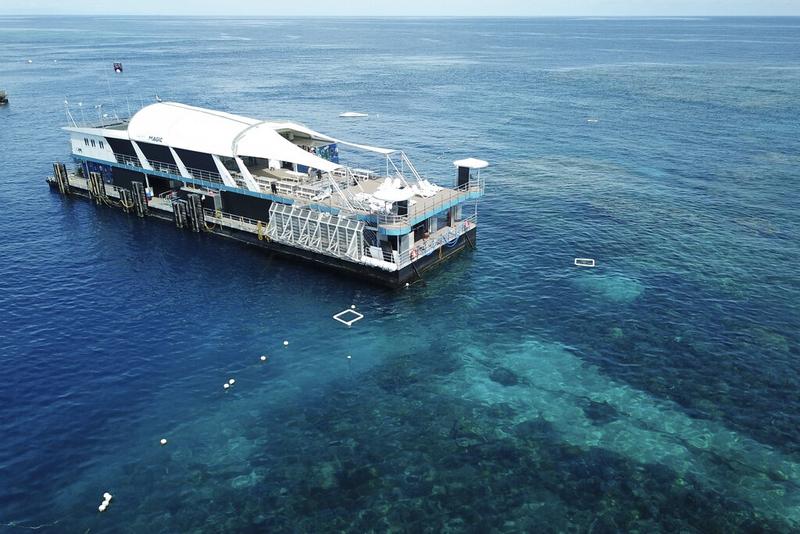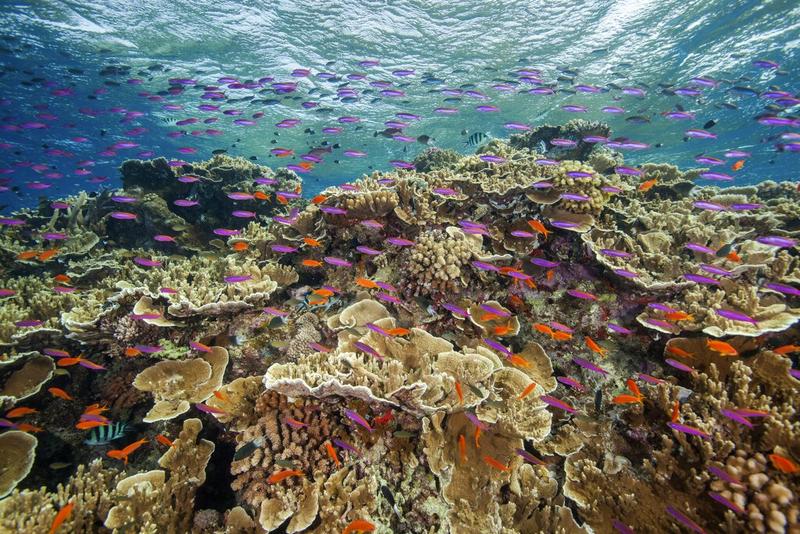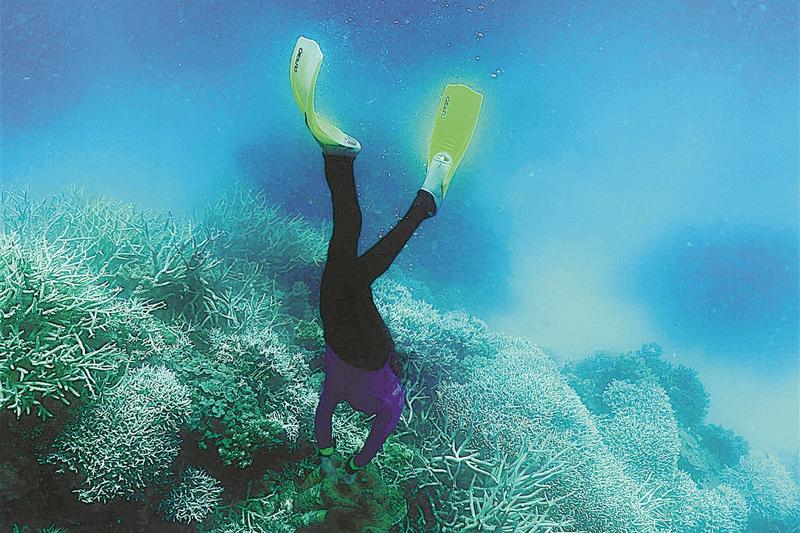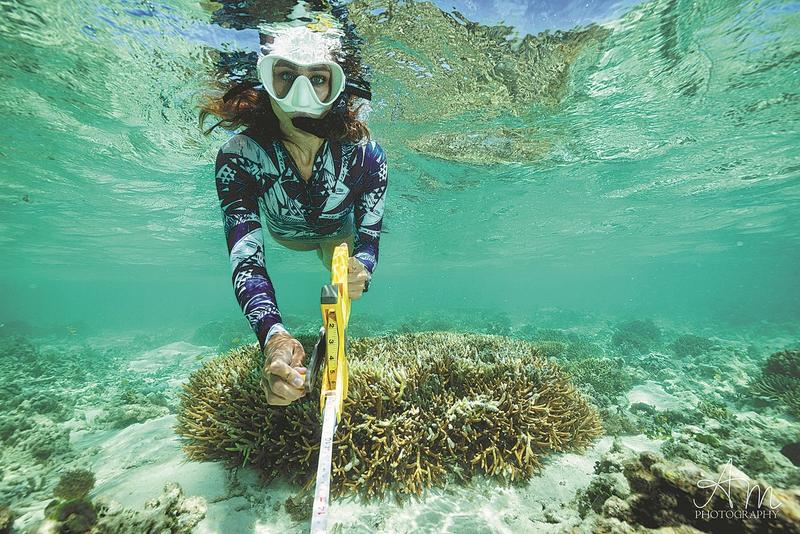Australian natural wonder may be added to UN list of endangered heritage sites
 The Remoora, a boat owned by Reef Magic, sits above a section of the Great Barrier Reef next to a coral spawning experiment off the coast of Queensland, Australia, on Nov 14. (PHOTO / AP)
The Remoora, a boat owned by Reef Magic, sits above a section of the Great Barrier Reef next to a coral spawning experiment off the coast of Queensland, Australia, on Nov 14. (PHOTO / AP)
When the United Nations' World Heritage Committee meets later this year, one of the items on the agenda will be whether Australia's Great Barrier Reef — considered one of the great natural wonders of the world — should be added to the List of World Heritage in Danger.
For decades, the reef has been living on borrowed time, due mainly to climate change, although pollution from agriculture and industry have also played their part.
British naturalist David Attenborough has described the reef as "one of the greatest and most splendid natural treasures that the world possesses".
With its unparalleled beauty and richness of biodiversity, the reef, which lies off the state of Queensland, comprises 2,900 individual reefs and 900 islands, and stretches for 2,300 kilometers.
It is also a major contributor to Australia's economy. According to the think tank Deloitte Access Economics, the Great Barrier Reef has an economic, social and icon asset value of A$56 billion ($37.8 billion). It supports more than 64,000 jobs and contributes A$6.4 billion to the Australian economy.
Previous attempts to place the reef on the List of World Heritage in Danger have been fiercely opposed by Australia.
Although no date has been set for the next meeting of the World Heritage Committee, which convenes once a year, it is a foregone conclusion the reef will be added to the list.
Such a move will spark a fierce political backlash, especially from Queensland. At federal level, the response might be more cautious following the general election in May, which saw the conservative government led by Scott Morrison replaced by a Labor administration more in tune with environmental issues.
Labor's Environment Minister, Tanya Plibersek, said on Nov 28 that the Great Barrier Reef is "one of the best-managed reefs in the world" and it "doesn't require an in-danger rating by UNESCO ... to make us take it seriously".
She said the new government headed by Prime Minister Anthony Albanese has increased Australia's emissions reduction target and boosted funding for reef protection.
 In this photo provided by the Great Barrier Reef Marine Park Authority small fish school in waters of Ribbon Reef No 10 near Cairns, Australia, Sept 12, 2017. (PHOTO / AP)
In this photo provided by the Great Barrier Reef Marine Park Authority small fish school in waters of Ribbon Reef No 10 near Cairns, Australia, Sept 12, 2017. (PHOTO / AP)
But no matter what the politicians say, they cannot escape the fact that climate change is having an impact on the future of coral reef systems, not only in Australia but around the world.
While such reefs cover less than 3 percent of the world's oceans, they contain 25 percent of all marine life. Next to tropical rainforests, they are the most biodiverse ecosystems on Earth.
Scientists say that without reefs, the 1 billion-plus people globally who rely on coral reefs for food, fisheries and livelihoods would be left devastated.
That climate change is warming the world's oceans is now beyond dispute — and the impact is being felt from the Arctic to the tropics.
One result of warming oceans, as far as coral is concerned, is bleaching, where the microscopic organisms that give coral its color and vibrancy simply die.
In recent years, coral bleaching has devastated large sections of the Great Barrier Reef.
In March, a report in the Smithsonian magazine said abnormally warm waters are stressing the reef, causing large parts of the usually colorful landmark to turn ghostly white.
"Aerial surveys detected catastrophic coral bleaching on around 60 percent of the reef's corals," the report said.
Australia is among 190 countries party to UNESCO's World Heritage Convention, which is aimed at conserving the world's most outstanding heritage sites.
The World Heritage Committee — a 21-member body established by the convention but with membership elected by the member states — decides which sites to place on the list.
Countries have to protect, conserve, communicate the value of, rehabilitate and "transmit" these sites to future generations.
For a site to be put on the list, the country it is situated in typically asks for help to address serious threats. But in cases of urgent need, the committee can inscribe a site immediately and without the agreement of the country concerned. Currently, 46 World Heritage sites, 20 of which are natural, are on the List of World Heritage in Danger.
 A diver explores the Great Barrier Reef. (PHOTO / AFP)
A diver explores the Great Barrier Reef. (PHOTO / AFP)
In 2021, UNESCO considered adding the Great Barrier Reef to the list. This brought an immediate response from the Australian government, which launched a diplomatic offensive against the reef being placed on the list.
At the time, UNESCO reiterated its belief that the reef merited a place on the list. Fanny Douvere, head of the UNESCO World Heritage Centre's marine program, said, "The facts are the facts, and the science is the science."
Australia's then-environment minister, Sussan Ley, who led the lobbying campaign to pull votes away from UNESCO and criticized how the organization made its recommendation, won a short reprieve, with the organization deferring any formal decision until this year.
In March, a team from UNESCO and the International Union for Conservation of Nature, or IUCN, conducted a further investigation on the reef's health.
In its joint report released on Nov 28, the team found the Great Barrier Reef had been "seriously impacted" by climate change, and its resilience "substantially compromised".
The document, Report on the Reactive Monitoring Mission to the Great Barrier Reef (Australia), 21-30 March 2022, said climate change presented a "serious challenge" to the values that saw the reef inscribed as a global wonder in 1981.
It said the reef has faced "considerable pressures" that threaten its future.
Those pressures include climate change, coastal development, degraded water quality resulting from sediment and pollutant runoff from agricultural activities, and unsustainable use of resources.
The report, recommending the reef be placed on a list of World Heritage sites in danger, will be considered alongside responses from the Queensland and federal governments before UNESCO makes a formal recommendation to the World Heritage Committee later this year.
Emma Camp, reef biogeochemistry group leader and deputy team leader for the Future Reefs Program at the University of Technology Sydney, said the report highlighted the immense threat that climate change presents to the Great Barrier Reef and that its resilience to recover from ongoing stress is severely compromised.
"Given the immense ecological and socioeconomic value of the Great Barrier Reef, we must act at all levels (political, management, scientific, public, economic) to ensure its future," she said.
 Kay Davis conducts a survey on the seabed off Heron Island in the Great Barrier Reef, Australia. (ASHLY MCMAHON / FOR CHINA DAILY)
Kay Davis conducts a survey on the seabed off Heron Island in the Great Barrier Reef, Australia. (ASHLY MCMAHON / FOR CHINA DAILY)
Jodie Rummer, professor of marine biology at James Cook University in Queensland, said the reef holds immense environmental, cultural and economic significance, and is an Australian and global icon.
"Heat-wave conditions are already being experienced across the reef, and some parts experienced record temperatures for November," Rummer said.
"This sparks fears that we'll add another year to the list of the six mass bleaching events (1998, 2002, 2016, 2017, 2020 and 2022) that the (Great Barrier Reef) has already faced.
"The science is clear. Climate change, driven by the burning of coal, oil and gas, is fueling repeated marine heatwaves that are devastating coral reefs not only in Australia but worldwide."
With global warming now expected to exceed the UN's 1.5 C level, warmer oceans will be fatal for most of the world's reef systems.
Rummer said UNESCO's recommendation to place the Great Barrier Reef on the World Heritage "in danger" list underlines the fact that "we need to do more, both urgently and rapidly, to cut emissions".
"Our action now will determine the frequency and severity of marine heat waves the reef will face over the coming years. Indeed, we are in a critical decade — every tenth of a degree, every week, every month, matters," she said.
However, Rummer is optimistic.
There is a huge opportunity to make a difference, she said, adding: "We can stop approving coal, oil and gas projects. We can shift to renewables, reduce our emissions by 75 percent by 2030, and reach net zero.
"We can emphasize here in Australia and on the global stage that we are serious about protecting the Great Barrier Reef and that we're willing to do the work to get there. It's worth it!"
Two experts — one from UNESCO and the other from the IUCN — met with Australian government officials, scientists and stakeholders in Queensland in March, two months before the Morrison government was defeated in the election.
 The Great Barrier Reef. (PHOTO / AP)
The Great Barrier Reef. (PHOTO / AP)
The UNESCO/IUCN report, which took almost six months to prepare, put forward 10 priority recommendations it said needed to be addressed "with utmost urgency".
"Implementing the recommendations could drastically improve (Australia's) ability to ensure and advance conservation of the reef and retain its 'outstanding universal value' for future generations," the report said.
The government's Reef 2050 plan needs to be strengthened before the end of this year to include "clear government commitments to reduce greenhouse emissions consistent with the efforts required to limit the global average temperature increase to 1.5 C above pre-industrial levels", the report added.
The Albanese government has put forward an improved national target to cut greenhouse gas emissions by 43 percent from 2005 levels by 2030, and to reach net zero by 2050.
Independent analysis has found Australia's new target consistent with keeping warming to 2 C — above the 1.5 C goal seen as critical for the reef's long-term health.
But the question remains: Will this be enough to keep the reef off the list?
Since 2010, the World Heritage Committee has raised concerns that activities within the Great Barrier Reef and its surrounding coastal areas are "irrevocably threatening "the future of the reef.
As far back as 2013, the committee wanted to place the reef on its List of World Heritage in Danger, but the Australian and Queensland governments managed to fend off each attempt to do so.
When the UNESCO/IUCN report was released, Anna Marsden, Great Barrier Reef Foundation managing director, said it "confirms what science has been telling us for some time" — that the Great Barrier Reef is under increasing pressure from climate change, poor water quality and crown-of-thorns starfish. Also known as COTS, these marine invertebrates feed on coral.
"We know our window to act is closing. It's why we show up every day, ready to do whatever it takes to protect and restore the reef and help it adapt to rising temperatures and other threats," Marsden said.
"We're working with more than 500 partners on the ground, in the water and in the lab, finding and growing bold, innovative and practical solutions to some of the most complex ecological challenges of our time."
UNESCO's report focuses only on the Great Barrier Reef, she said, adding, "It is important to state that the threats our reef faces are shared by every coral reef in the world.
"This is an ecosystem-wide challenge, not one only felt by Australia. If ever there was a time to come together for the world's coral reefs and oceans, it is now. We must all act — they need us now more than ever."


